Work zone safety a concern for town, state road crews
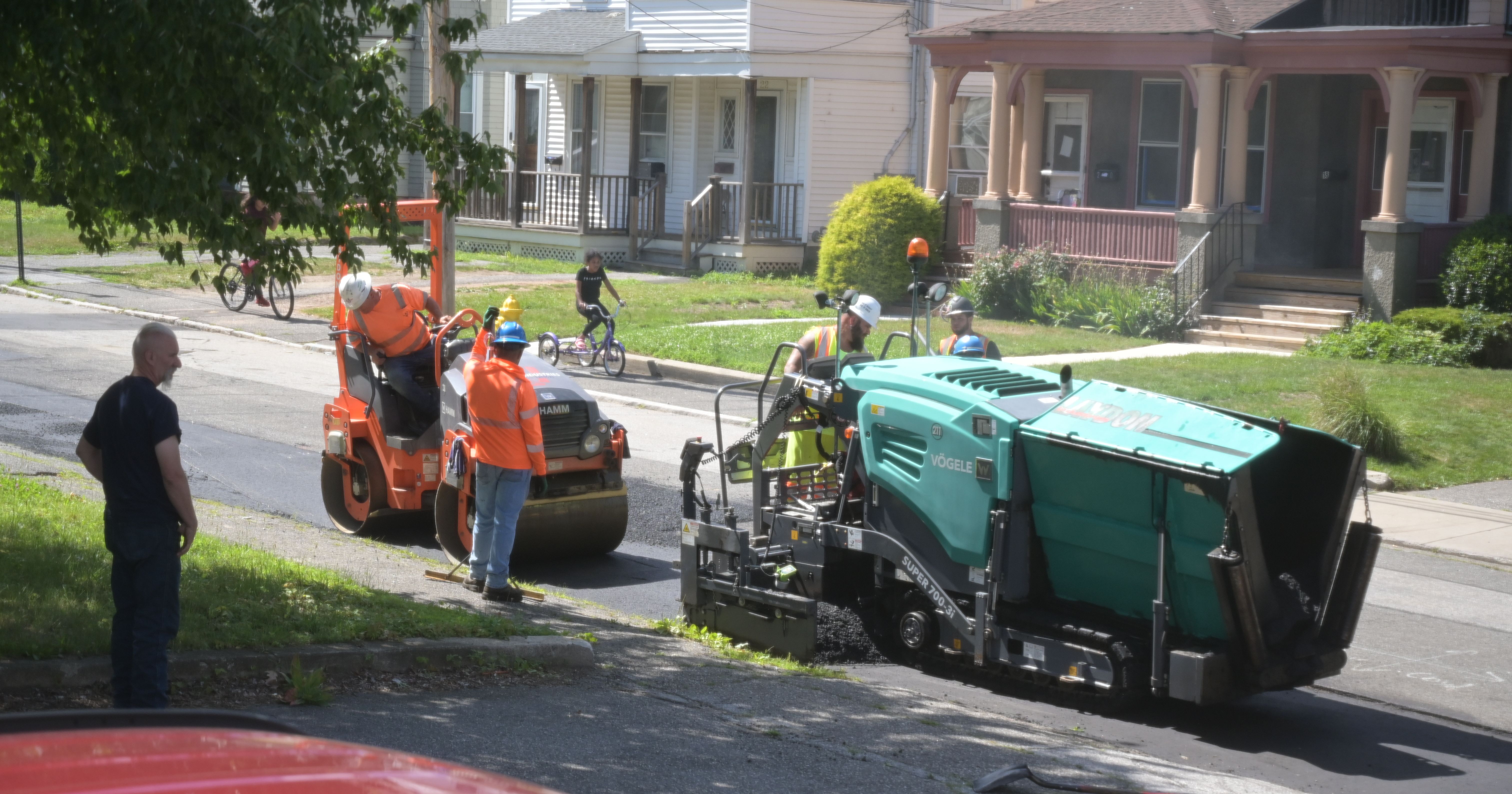
Road crew safety has been a cause for concern with 71 car strikes on crews in Connecticut so far in 2024.
Provided

Road crew safety has been a cause for concern with 71 car strikes on crews in Connecticut so far in 2024.
“When a worker is killed by an impaired driver at 9 o’clock in the morning while picking up litter tossed out car windows, we have a much greater crisis on our hands.” — Garrett Eucalitto, state Department of Transportation (DOT) commissioner
SHARON — An agitated driver recently ignored commands from a member of the town’s highway department to stop during a roadway construction project. Instead, the motorist maneuvered around the work zone.
“He got angry and drove off the road and popped two tires,” said Casey Flanagan, Sharon’s First Selectman. “I have heard stories that people are speeding through our work zones, or they get impatient or agitated because they need to stop,” he said.
Just recently, Flanagan noted, a worker on the road crew reported that “somebody stuck their middle finger up at the guys” as they drove through the work zone. “It’s really unfair. They are just doing their job and they want to keep the traffic moving.”
With road construction and paving projects in full swing and following the recent deaths of three workers on Connecticut roadways in the past two months, state and local officials are pleading with drivers to slow down and pay attention when approaching work zones. Poor driving habits like speeding, inattentiveness and operating a motor vehicle while impaired are not only dangerous, they noted, but they can have deadly consequences to both the worker and the driver.
On Wednesday, July 3, there was a close call on Route 8 in Litchfield when a motorist in the northbound lane veered off the road and crashed into an unmanned state Department of Transportation (DOT) vehicle as workers were out mowing. The driver sustained minor injuries and was issued an infraction for failure to maintain proper lane, according to Connecticut State Police.
The accident occurred less than 24 hours after Gov. Ned Lamont and state DOT Commissioner Garrett Eucalitto gave a press conference on work zone safety, and one week after a state DOT worker was fatally struck by a suspected impaired driver while picking up litter along an on ramp in Wallingford.
According to state public safety officials, there were 14 strikes on work zone crews by vehicles during June, and 71 strikes on crews to date this year as of July 2. In 2023, DOT reported 141 crashes into work trucks, despite enhanced signage and warnings.
From 2020 to 2022, there were more than 2,500 crashes and 10 fatalities in work zones, according to state officials.
“This crisis needs everyone’s attention,” Eucalitto said. “When a worker is killed by an impaired driver at 9 o’clock in the morning while picking up litter tossed out car windows, we have a much greater crisis on our hands.”
To combat speeding through work zones, from April to December 2023, DOT ran a Work Zone Speed Camera pilot program. During that period, 541,920 vehicles were found speeding in work zones, according to DOT spokesperson Samaia Hernandez. Written warnings were issued by mail to 24,875 drivers, and citations for repeat violations were issued to 724 drivers.
The program, said Lamont during the press conference, will become permanent at work zones around the state. “We will see how fast you are going into that work site and see what you are doing on the way out. We will take a picture of your license plate and you will be held accountable.”
Speed on rural roads a major concern
Work zone dangers are not lost on town highway crews in the rural Northwest Corner.
Speed is their biggest concern, followed by distracted driving and aggressive behavior, according to highway department workers.
“We definitely see a lot of speeding,” and drivers on their cell phones, reported Russell Hoage crew chief for the Salisbury Highway Department. “They just don’t slow down.” Most roads have a 30 to 35 posted speed limit, he said, and it’s not unusual to see drivers whizzing by work zones at 40 to 45 miles per hour.
To help buffer road crews from oncoming traffic, the town highway department often uses dump trucks as protective crash barriers, the road crew chief noted.
Hoage said he is at a loss as to why some drivers fail to see the danger they are posing to themselves and to highway personnel. “I don’t know if people are just not aware of the danger, of if they just don’t care.”
Road foreman Rick Osborne, who has been with the Kent Highway Department for 27 years, said electric cars often catch road crews by surprise. “You can’t hear them coming, so they quickly sneak right up on you. And depending on the equipment being operated, it’s sometimes hard to hear oncoming traffic.”
He also noted that the suspensions on newer cars could be making higher speeds less noticeable to drivers.
Osborne said the department has enhanced its safety measures, including posting warning signs and reflective cones as far out as possible, especially where there are curves in the roads leading to work zones.
“If the cleaning crew is out, we park a truck between them and the approaching traffic, and never work behind the truck” to avoid a worker from being pinned between the vehicles, the Kent road foreman explained.
Then there are the drivers who are just plain rude. “Just the other day one of our guys waved to a driver to slow down,” Osborne recalled. “The driver stopped and said, ‘You can’t tell me to slow down or not to slow down!’”
‘Always expect the unexpected’
At the North Canaan Public Works Department, Stanley Morby said he’s seen drivers go to great lengths to get through a construction zone. “We recently had North Elm closed, and had drivers go right by the barriers, thinking there may only be a tree down or something, and they had to turn around and go back.”
His words of advice to drivers are to “slow down and pay attention to your surroundings, no different than if you see a couple of kids walking down the side of the road. Always expect the unexpected.”
Sharon’s first selectman said the heightened dangers facing road crews will spur future conversations about what the town can do to enhance worker safety.
“It’s unsafe for motorists as well,” Flanagan noted. “Sometimes there’s tree work being done, with limbs falling from a 50-foot height and somebody will run through the stop sign from the guys directing traffic. Someone can get really seriously hurt. We need patience from people.”
Flanagan suggested that drivers allow a little extra time if they are heading to work or to an appointment and expect to be traveling through a work zone. “Unfortunately,” he noted, “a lot of the work we do is between working hours when people are commuting.”
Lamont had this message for drivers: “We have thousands of people working along the sides of roads right now. I need folks to look out for each other. I need you to say to somebody who is driving a car that shouldn’t be driving a car to pull over. I need you to say if somebody is busy texting and not paying attention, stop it. We’re doing everything we can as a state to take the lead on this, but the rest really is up to you.”
Wes Allyn breaks away from the St. Paul defense for a reception touchdown Wednesday, Nov. 26.
BRISTOL — The Gilbert/Northwestern/Housatonic co-op football team ended the season with a 34-0 shutout victory over St. Paul Catholic High School Wednesday, Nov. 26.
It was GNH’s fourth consecutive Turkey Bowl win against St. Paul and the final game for 19 GNH seniors.
The Yellowjacket defense played lights out, holding St. Paul’s offense to 73 total yards and forcing three turnovers. Owen Riemer and Tyler Roberts each caught an interception and Jacob Robles recovered a fumble.
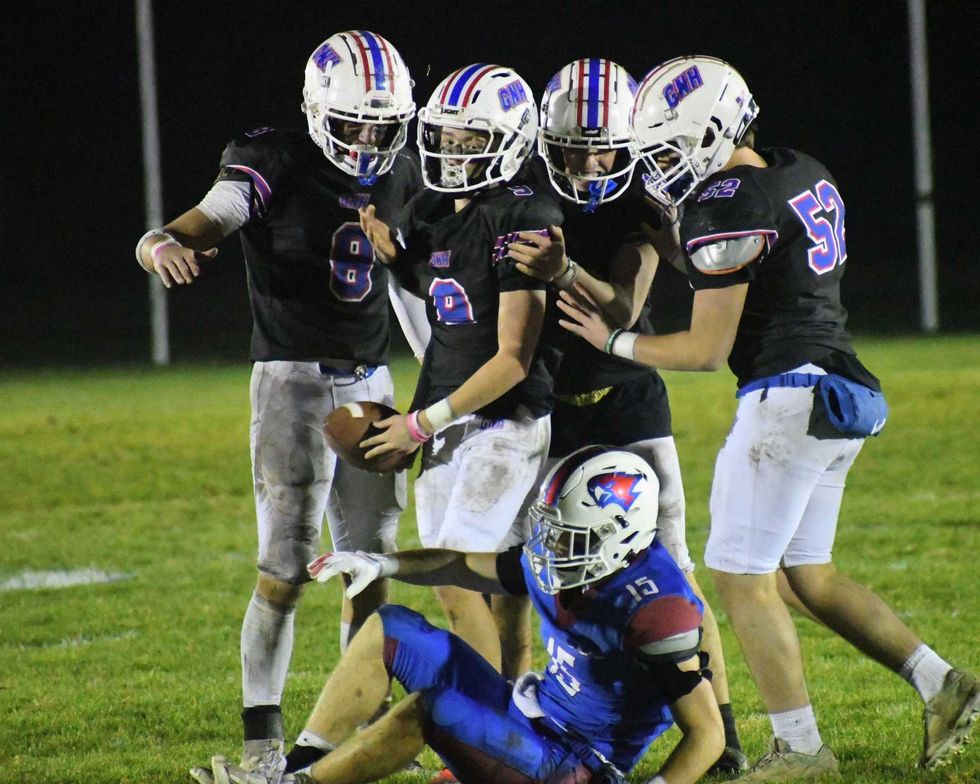
QB Trevor Campbell threw for three touchdowns: one to Wes Allyn, one to Cole Linnen and one to Esten Ryan. GNH scored twice on the ground with rushing touchdowns from Linnen and Riemer.
The game concluded in some confusion. A late run by Linnen ended when he was tackled near the end zone. The ball was spotted at the one-yard line and GNH took a knee to end the fourth quarter with the scoreboard reading 28-0. After the game, Linnen’s run was reassessed as a touchdown, and the final score was adjusted to 34-0.
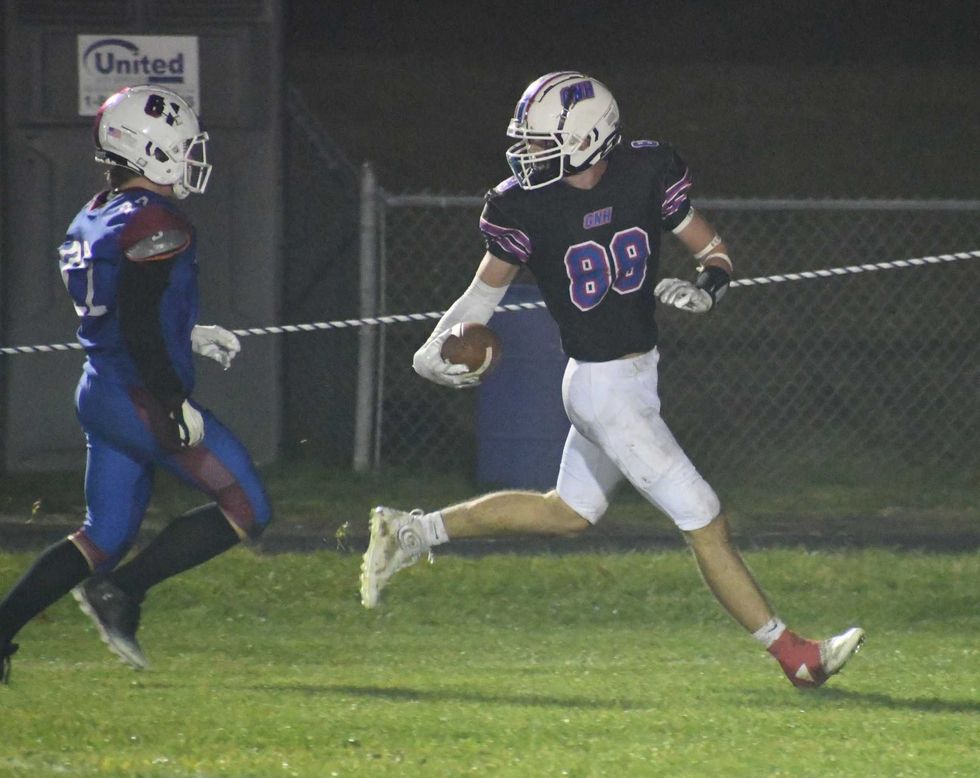
Coach Scott Salius was thankful that his team went out on a high note. “We’re one of the few teams in the state that will finish with a win.” He commented on the “chippiness” of this year’s Thanksgiving matchup. “We have started a true rivalry.”
GNH won four of the last five games and ended with a record of 5-5.
“Battling back from 1-4, huge turnaround. I couldn’t be happier,” said GNH captain Wes Allyn after the win. “Out of the four years I’ve been playing, undefeated on Thanksgiving. No one will ever take that away from me.”
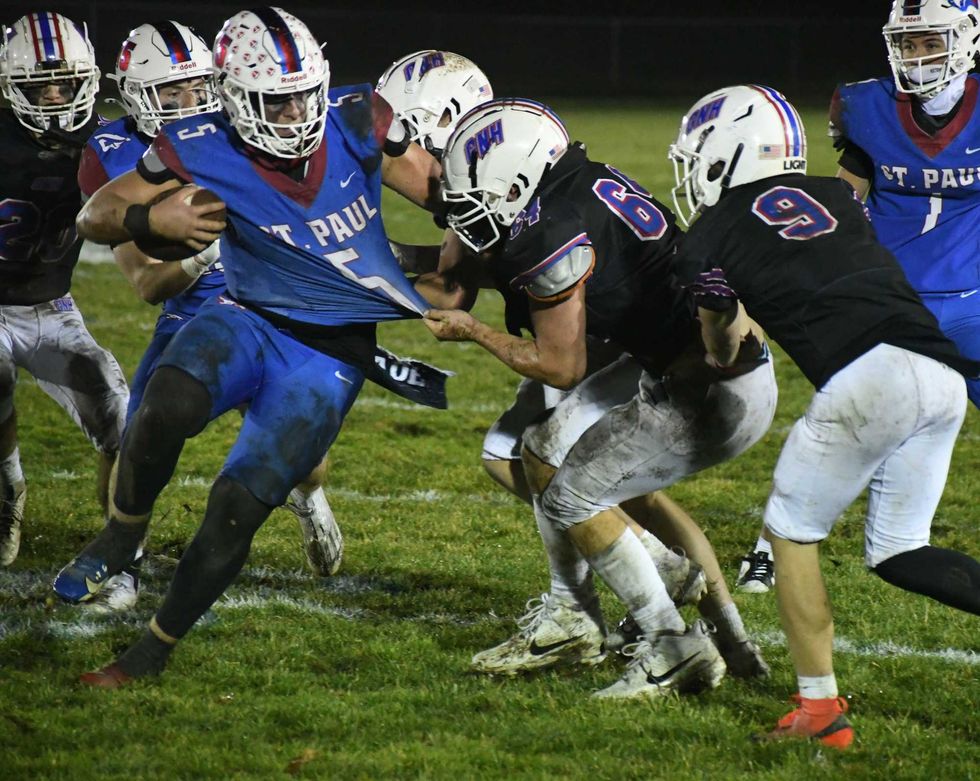
Looking back on his final varsity season, Nick Crodelle said he will remember “practice, complaining about practice, and getting ready for the games. Game day was a lot of fun.”
Hunter Conklin said ending on a win “feels great” and appreciated his time on the field with his teammates. “There’s no one else I’d rather do it with.”
“I’m so thankful to have these guys in my life,” said Riemer. “It’s emotional.”
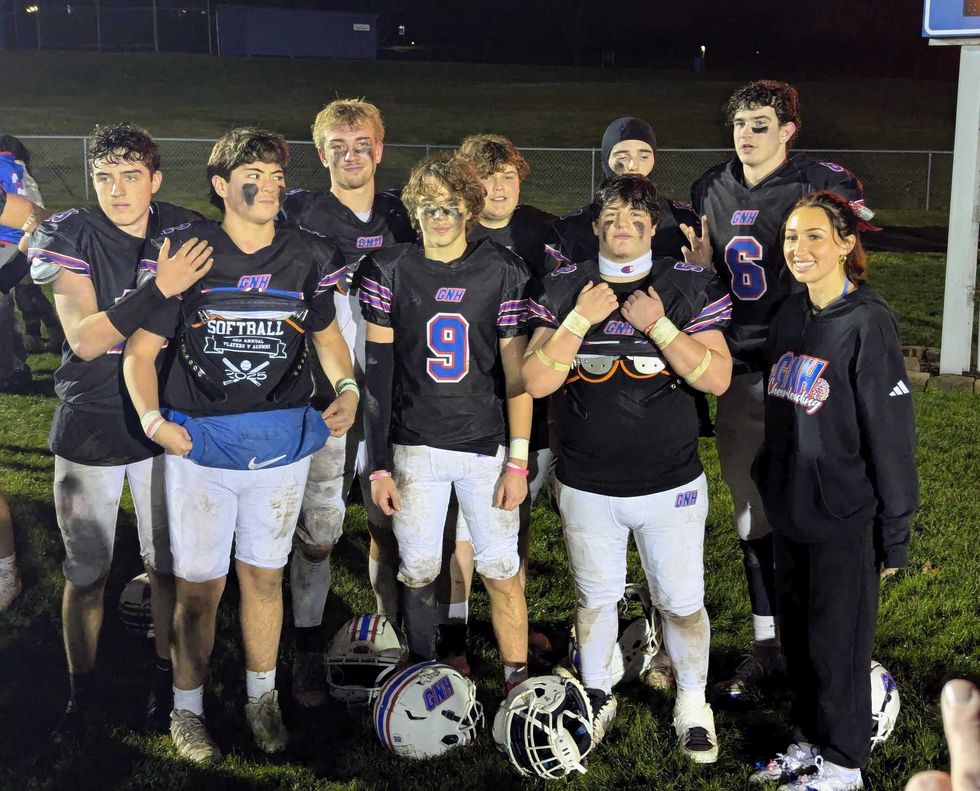
“Once Upon a Time in America” features ten portraits by artist Katro Storm.
The Kearcher-Monsell Gallery at Housatonic Valley Regional High School in Falls Village is once again host to a wonderful student-curated exhibition. “Once Upon a Time in America,” ten portraits by New Haven artist Katro Storm, opened on Nov. 20 and will run through the end of the year.
“This is our first show of the year,” said senior student Alex Wilbur, the current head intern who oversees the student-run gallery. “I inherited the position last year from Elinor Wolgemuth. It’s been really amazing to take charge and see this through.”
Part of what became a capstone project for Wolgemuth, she left behind a comprehensive guide to help future student interns manage the gallery effectively. “Everything from who we should contact, the steps to take for everything, our donors,” Wilbur said. “It’s really extensive and it’s been a huge help.”
Art teacher Lilly Rand Barnett first met Storm a few years ago through his ICEHOUSE Project Space exhibition in Sharon, “Will It Grow in Sharon?” in which he planted cotton and tobacco as part of an exploration of ancestral heritage.
“And the plants did grow,” said Barnett. She asked Storm if her students could use them, and the resulting work became a project for that year’s Troutbeck Symposium, the annual student-led event in Amenia that uncovers little-known or under-told histories of marginalized communities, particularly BIPOC histories.
Last spring, Rand emailed to ask if Storm would consider a solo show at HVRHS. He agreed.
And just a few weeks ago, he arrived — paints, brushes and canvases in tow.
“When Katro came to start hanging everything, he took up a mini art residency in Ms. Rand’s room,” Wilbur said. “All her students were able to see his process and talk to him. It was great working with him.”
Perhaps more unexpected was his openness. “He really trusted us as curators and visionaries,” Wilbur said. “He said, ‘Do with it what you will.’”

Storm’s artistic training began at New Haven’s Educational Center for the Arts. His talent earned him a full scholarship to the Arts Institute of Boston, then Boston’s Museum School, where he painted seven oversized portraits of influential Black figures — in seven days — for his final project. Those works became the backbone of his early exhibitions, including at Howard University’s National Council for the Arts.
Storm has created several community murals like the 2009 READ Mural featuring local heroes, and several literacy and wellness murals at the Stetson Branch Library in New Haven. Today, he teaches and works, he said, “wherever I set up shop. Sometimes I go outside. Sometimes I’m on top of roofs. Wherever it is, I get the job done.”
His deep ties to education made a high school gallery an especially meaningful stop. “No one really knew who these people were except maybe John Lennon,” Storm said of the portraits in the show. “It’s really important for them to know James Baldwin and Shirley Chisholm. And now they do.”
The exhibition includes a wide list of subjects: James Baldwin, Shirley Chisholm, Redd Foxx, Jasper Johns, Marilyn Manson, William F. Buckley, Harold Hunter, John Lennon, as well as two deeply personal works — a portrait of Tracy Sherrod (“She’s a friend of mine… She had an interesting hairdo”) and a tribute to his late friend Nes Rivera. “Most of the time I choose my subjects because there are things I want to see,” Storm said.
Storm’s paintings, which he describes as “full frontal figuratism,” rely on drips, tonal shifts, and what feels like emerging depth. His process moves quickly. “It depends on how fast it needs to get done,” he said. “Sometimes I like to take the long way up the mountain. Instead of doing an outline, I just start coloring, blocking things off with light and dark until it starts to take shape.”
He’s currently in a black-and-white phase. “Right now, I’m inspired by black and white, the way I can really get contrast and depth.”
Work happens on multiple canvases at once. “Sometimes I’ll have five paintings going on at one time because I go through different moods, and then there’s the way the light hits,” he said. “It’s kind of like cooking. You’ve got a couple things going at once, a couple things cooking, and you just try to reach that deadline.”
For Wilbur, who has studied studio arts “ever since I was really young” and recently applied early decision to Vassar, the experience has been transformative. For Storm — an artist who built an early career painting seven portraits in seven days and has turned New York’s subway corridors into a makeshift museum — it has been another chance to merge artmaking with education, and to pass a torch to a new generation of curators.
Le Petit Ranch offers animal-assisted therapy and learning programs for children and seniors in Sheffield.
Le Petit Ranch, a nonprofit offering animal-assisted therapy and learning programs, opened in April at 147 Bears Den Road in Sheffield. Founded by Marjorie Borreda, the center provides programs for children, families and seniors using miniature horses, rescued greyhounds, guinea pigs and chickens.
Borreda, who moved to Sheffield with her husband, Mitch Moulton, and their two children to be closer to his family, has transformed her longtime love of animals into her career. She completed certifications in animal-assisted therapy and coaching in 2023, along with coursework in psychiatry, psychology, literacy and veterinary skills.
Le Petit Ranch operates out of two small structures next to the family’s home: a one-room schoolhouse for animal-assisted learning sessions and a compact stable for the three miniature horses, Mini Mac, Rocket and Miso. Other partner animals include two rescued Spanish greyhounds, Yayi and Ronya; four guinea pigs and a flock of chickens.
Borreda offers programs at the Scoville Library in Salisbury, at Salisbury Central School and surrounding towns to support those who benefit from non-traditional learning environments.
“Animal-assisted education partners with animals to support learning in math, reading, writing, language and physical education,” she said. One activity, equimotricité, has children lead miniature horses through obstacle courses to build autonomy, confidence and motor skills.

She also brings her greyhounds into schools for a “min vet clinic,” a workshop that turns lessons on dog biology and measuring skills into hands-on, movement-based learning. A separate dog-bite prevention workshop teaches children how to read canine body language and respond calmly.
Parents and teachers report strong results. More than 90% of parents observed greater empathy, reduced anxiety, increased self-confidence and improved communication and cooperation in their children, and every parent said animal-assisted education made school more enjoyable — with many calling it “the highlight of their week.”

Le Petit Ranch also serves seniors, including nursing home residents experiencing depression, social withdrawal or reduced physical activity. Weekly small-group sessions with animals can stimulate cognitive function and improve motor skills, balance and mobility.
Families can visit Le Petit Ranch for animal- assisted afterschool sessions, Frech immersion or family walks. She also offers programs for schools, libraries, community centers, churches, senior centers and nursing homes.
For more information, email info@lepetitranch.com, visit lepetitranch.com, follow @le.petit.ranch on Instagram or call 413-200-8081.